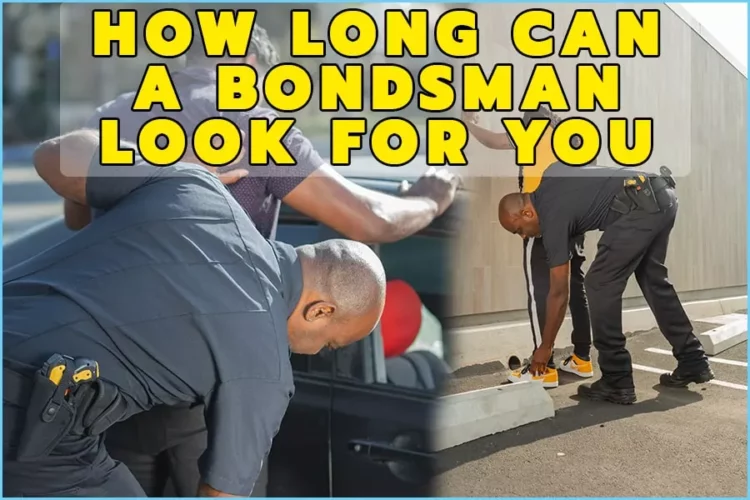Generally, court appearances are usually stressful. You have to pay some money to avoid going to jail while waiting for a court appearance. Bail bonds can help reduce the burden.
Today, most defendants use bail bonds to secure their freedom between court appearances. The bail bond agency pledges money as surety that the defendant will appear in court. However, if you choose to skip the trial, a bail bondsman has to reach you.
So, find out more about bail bonds in the next part, which answers the question.
How Long Can a Bondsman Look For You?
The bail bondsman will surely chase you until the warranty execution. Therefore they can look for you in days, months, and even years. Bounty hunters have too many resources at their disposal. Plus, they are so perfect and experienced at tracking people.
The Meaning Of “Bail”
Bail is simply an understanding between the court and you, the defendant. As a defendant, you will have to pay some money to the court. The money assures the defendant will appear in court on the set trial date.
If you appear in trials as scheduled, the court reimburses the money. The court still reimburses the money even if you get a conviction at your trial. But if you fail to appear in any trials, the court forfeits the money and issues an arrest warrant.
Contrarily, if you’re unable to pay bail, you’ll be in jail until your trial date. Inability to post bail can be so stressful. Therefore this is the main reason why people consider the bail bond agencies.
How Bail Bonds Work
Typically, bail bonds function similarly to personal loans. You have to pay some percentage of the whole amount first. Then the bail agent will hand you the remaining amount you need.
For example, if the court gives a bail of $15,000, you will have to deposit approximately $2,000 first. The bail agent will then give you the remaining $15,000.
However, note that most bail bond companies will need you to offer collateral. It can be your car, house deed, or jewelry item. Bail bond agencies use collateral to secure the bail bond if you don’t appear for your trial.
But if you attend all trials, you’ll get the money back from the court. You can then return it to the company that gave it to you.
Note that bail bond agencies are making a huge financial risk with this loan. Therefore they have additional precautions that will make you attend all your trials. The bail bondsman wants to ensure you pay back the company its money. The precautions include things like.
- Bail bond companies prefer a friend or family property as collateral. You will less likely miss a trial because the property in line is for someone so close.
- The companies will require you to make regular visits to their offices. It helps them confirm that you haven’t left town.
- They regularly call to remind you of your trial.
These precautions aren’t so extreme if you want to stay out of jail while waiting for trial.
How Bail Bonds Work
After an arrest, the court will give you a hearing date and bail amount. It’ll be up to you, your family, and your friends to pay the bail. If you do not have the whole amount at hand, you can get help from a bail bondsman.
After the bail bondsman posts the bail, the defendant must ensure they attend all the hearings. If the defendant skips bail, the bondsman becomes a bounty hunter. They will look for the accused and return them to court.
The court offers a grace period where the defendant can return to court and the bail money released. If the person doesn’t appear for the hearing, the company’s amount is put up and taken by the court. The company then takes collateral acting as security from family/friends.
Therefore it’s so important for a defendant to appear in court.
The Different Types Of Bonds
Federal Bail Bond
If accused of interstate or federal crime, the defendant will have to post a federal bail bond for release. A federal bail bond has higher collateral. Some federal crimes include hate crimes, bank robbery, kidnapping, etc.
Cash Bond
It’s the simplest payment form. Here the accused pays the court the full bail amount in cash, credit card, or check. However, note that not all county courts accept credit cards.
Citation Release
A citation release is simply a notice from the arresting officer. The written notice allows the accused to go home and is not in jail after arrest. However, they must appear before the court. The citation release is common in minor crimes.
Surety Bond
The surety bond is typically what the article is talking about. It involves a third-party agent who steps in to pay the bail bond. That’s if the accused fails to show up for trial.
Immigration Bail Bond
The immigration bond applies to individuals detained for immigration reasons. The difference between this bond and the surety bond is that it deals with immigration. However, the bail is usually lighter than others because of the crime’s nature.
Property Bond
In this situation, your property acts in place of cash. It means the court will seize property if the defendant doesn’t appear in court.
Personal Recognizance Release
The bail is for a person the court deems not harmful to the community or a flight risk. It majorly applies to people who have committed minor crimes. They’ll not have to pay out any bail money.
How Long Does It Take For One To Get Out Of Jail After Posting Bail?
The time varies because many factors determine it. As mentioned, bail assures the court that a defendant will appear in court for all trials. The bail amount varies according to the severity and type of charges.
If you want to post bail for a loved one in jail, you must perfectly understand the process. Plus, know how long the process takes. The amount of time you’ll remain in jail after paying bail varies from case to case. Here is more information on things that influence your time in jail.
Traffic
Like other public offices, your time in jail after paying bail depends on how busy it is. If you post bail in jail with many defendants, it’ll take more than half a day. The number of traffic cases will hugely affect your time in jail.
Paperwork
Bailing out a defendant usually involves a lot of paperwork. Usually, the officer that oversees the bailing process must keenly check out the paperwork before releasing the person. The officers also must ensure that the defendant doesn’t have multiple warrants.
Staff
Financial constraints make courts work with limited resources, which include staff. Imagine going to a court and finding out that only two people are working. Or a person is held in a jailhouse with only two officers on duty.
The number of staff at the jailhouse will affect how fast the release will be.
Is It Possible To Bail Out A Person At Night?
Almost all bail bond companies operate 24/7. Therefore a friend or family member can seek their services at any time. However, the amount of time you’ll spend after bail payment depends on staff, paperwork, etc. It’s advisable always to use a bond dealer near you.
Conditions of Bail
The law allows judges to change bail schedules depending on the case specifics and the individual’s criminal history. For example, the severity of one’s case can make the judge deny them a flight risk.
If you get out of jail, there are some requirements for you to be out of custody. They include:
- House arrest
- Electronic monitoring
- Surrender weapons to ideal law enforcement
- Complete a mental health treatment and substance abuse program
- Prohibitions, driving restrictions, travel
- Frequent check-in with the probation officer in person or online
Quick Facts
The bail bond business is not a common practice in the world. The practice is only in America and the Philippines. However, USA states do not have bail bonds, such as Washington, Oregon, Maine etc.
The amount of bail and how it works depends on your particular state. Various states have setlists that help judges determine the proper bail amount for a certain crime.
In Idaho, the minimum amount required to post bail is $50, which includes a 10% premium. Additionally, the state mandates a $35 bail fee and a jail fee that ranges from $10 to $25, varying based on the county. For example, Boise bail bonds are best settled by agents who can efficiently navigate the legal process.
Conclusion
Did you miss a trial, and you’re now wondering how long can a bondsman look for you. Bail bond companies will help you get out of jail while waiting for trials. The bail guarantees that you’ll appear in court at the stated trial dates.
If you fail to appear for any trial, the court holds the bail amount, which means the bail bond company will lose money. Therefore most bail bond companies have bondsmen who will trace and avail you to your trial.
The bondsman will look for you until the warranty execution.









